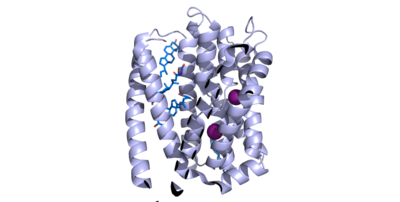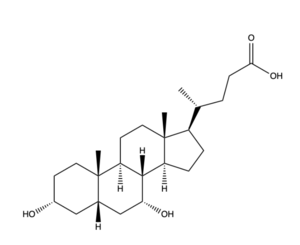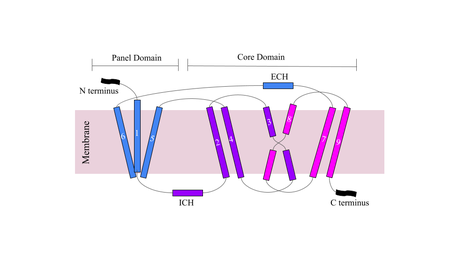Sandbox Reserved 1783
From Proteopedia
(Difference between revisions)
| Line 27: | Line 27: | ||
=== Conformation Change === | === Conformation Change === | ||
| - | The conformational change of NTCP's core domain helices is essential to bile salt binding and uptake. Helices 3 and 8 <scene name='95/952711/X_motif/3'>X motif</scene> are the main structural components of the conformational change, as the X motif has highly conserved polar residue motifs that reside near the bile salt transport sites. The conformational change is energized by the movement of Na+ down its concentration gradient. Before bile salt can bind, the pore in which salt binds must be <scene name='95/952711/Open_pore_ntcp_non_transparent/3'>open</scene>. Conserved glycine and proline residues act as hinges in the connecting short loops, intracellular α-helix, and extracellular α-helix of NTCP to facilitate the movement of the core and panel domain to allow for a conformational change. The <scene name='95/952711/Open_pore_ntcp/ | + | The conformational change of NTCP's core domain helices is essential to bile salt binding and uptake. Helices 3 and 8 <scene name='95/952711/X_motif/3'>X motif</scene> are the main structural components of the conformational change, as the X motif has highly conserved polar residue motifs that reside near the bile salt transport sites. The conformational change is energized by the movement of Na+ down its concentration gradient. Before bile salt can bind, the pore in which salt binds must be <scene name='95/952711/Open_pore_ntcp_non_transparent/3'>open</scene>. Conserved glycine and proline residues act as hinges in the connecting short loops, intracellular α-helix, and extracellular α-helix of NTCP to facilitate the movement of the core and panel domain to allow for a conformational change. The <scene name='95/952711/Open_pore_ntcp/3'>open</scene> pore is flipped toward the outer membrane to allow for bile salt binding by exposing the Na+ binding sites and the X motif within NTCP. Once <scene name='95/952711/Open_pore_with_bile_salts/3'>bound</scene>, the pore is <scene name='95/952711/Closed_pore_ntcp/2'>closed</scene>, and bile salt is able to be released into the cell, past the inner membrane. <ref name="Goutam"/> |
=== Mechanism === | === Mechanism === | ||
Revision as of 00:25, 17 April 2023
| This Sandbox is Reserved from February 27 through August 31, 2023 for use in the course CH462 Biochemistry II taught by R. Jeremy Johnson at the Butler University, Indianapolis, USA. This reservation includes Sandbox Reserved 1765 through Sandbox Reserved 1795. |
To get started:
More help: Help:Editing |
Sodium Taurocholate Co-Transporting Peptide
| |||||||||||
References
- ↑ 1.0 1.1 1.2 1.3 1.4 Goutam, K., Ielasi, F.S., Pardon, E. et al. Structural basis of sodium-dependent bile salt uptake into the liver. Nature 606, 1015–1020 (2022). DOI: 10.1038/s41586-022-04723-z.
- ↑ Maldonado-Valderrama, J., Wilde, P., Macierzanka, A., & Mackie, A. (2011). The role of bile salts in digestion. Advances in colloid and interface science, 165(1), 36–46. DOI: 10.1016/j.cis.2010.12.002.
- ↑ 3.0 3.1 Asami J, Kimura KT, Fujita-Fujiharu Y, Ishida H, Zhang Z, Nomura Y, Liu K, Uemura T, Sato Y, Ono M, Yamamoto M, Noda T, Shigematsu H, Drew D, Iwata S, Shimizu T, Nomura N, Ohto U. Structure of the bile acid transporter and HBV receptor NTCP. Nature. 2022 Jun; 606 (7916):1021-1026. DOI: 10.1038/s41586-022-04845-4.
- ↑ Xiangbing Qi, Wenhui Li. (2022). Unlocking the secrets to human NTCP structure. The Innovation, Vol. 3, Issue 5. 100294, ISSN 2666-6758, DOI: 10.1016/j.xinn.2022.100294.
- ↑ Liu, H., Irobalieva, R.N., Bang-Sørensen, R. et al. The structure of human NTCP reveals the basis of recognition and sodium-driven transport of bile salts into the liver. Cell Res 32, 773–776 (2022). DOI: 10.1038/s41422-022-00680-4.
- ↑ Vlahcevic, Z., Buhac, I., et al. Bile Acid Metabolism in Patients with Cirrhosis. Gastroenterology vol. 60, 491-498 (1971). DOI: 10.1016/S0016-5085(71)80053-7.




